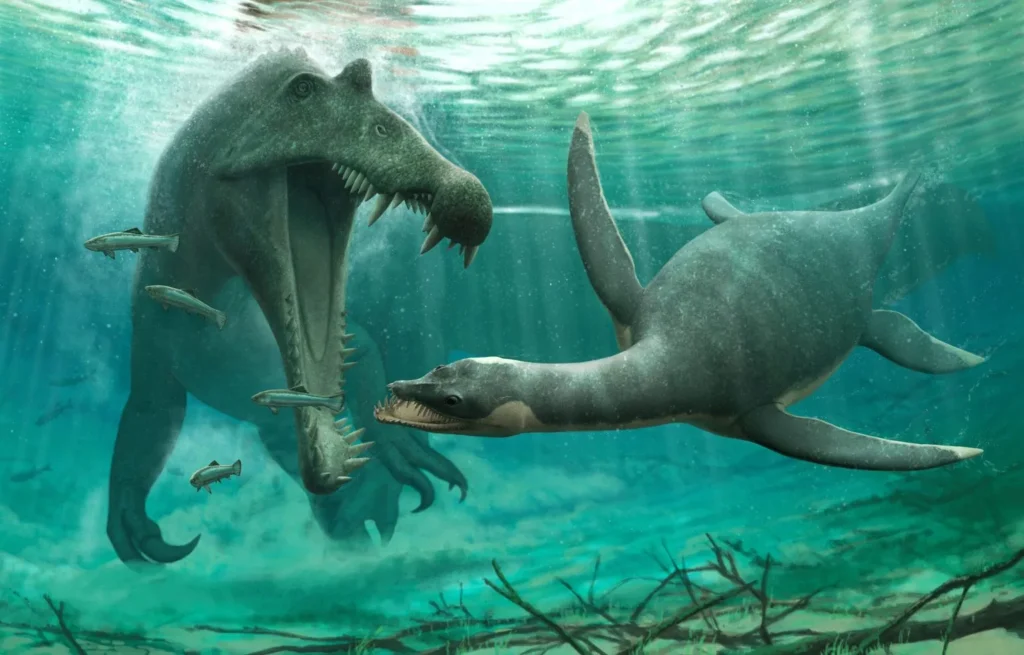
” … we paleontologists have always called them ‘marine reptiles’, they had to live in the sea? Lots of marine lineages invaded freshwater.”
Freshwater dolphins evolved at least four times — in the Ganges River, the Yangtze River, and twice in the Amazon. A species of freshwater seal inhabits Lake Baikal, in Siberia, so it’s possible plesiosaurs adapted to freshwater as well.
The plesiosaurs belong to the family Leptocleididae — a family of small plesiosaurs often found in brackish or freshwater elsewhere in England, Africa, and Australia. And other plesiosaurs, including the long-necked elasmosaurs, turn up in brackish or fresh waters in North America and China.
Plesiosaurs were a diverse and adaptable group and were around for more than 100 million years. Based on what they’ve found in Africa — and what other scientists have found elsewhere – the authors suggest they might have repeatedly invaded freshwater to different degrees.
The likely size of the plesiosaurs in this river system. Credit: Dr. Nick Longrich/University of Bath
“We don’t really know, honestly. That’s how paleontology works. People ask, how can paleontologists know anything for certain about the lives of animals that went extinct millions of years ago? The reality is, we can’t always. All we can do is make educated guesses based on the information we have. We’ll find more fossils. Maybe they’ll confirm those guesses. Maybe not.”
“It’s been really interesting to see the direction this project has gone in,” said lead author Georgina Bunker. The study initially began as an undergraduate project involving a single bone, but over time, more plesiosaur fossils started turning up, slowly providing a clearer picture of the animal.
The new discovery also expands the diversity of Morocco’s Cretaceous. Said Dr. Samir Zouhri, “This is another sensational discovery that adds to the many discoveries we have made in the Kem Kem over the past fifteen years of work in this region of Morocco. Kem Kem was truly an incredible biodiversity hotspot in the Cretaceous.”
“What amazes me,” said coauthor Dave Martill, “is that the ancient Moroccan river contained so many carnivores all living alongside each other. This was no place to go for a swim.”
But what does this all mean for the Loch Ness Monster? On one level, it’s plausible. Plesiosaurs weren’t confined to the seas, they did inhabit freshwater. But the fossil record also suggests that after almost a hundred and fifty million years, the last plesiosaurs finally died out at the same time as the dinosaurs, 66 million years ago..”
New Plesiosaur Fossil Discovery – What It Means for the Loch Ness Monster (scitechdaily.com)

The Scots were characteristically canny in the geographical situating of their national mythical beast. Choosing a specific but large inland freshwater loch in the heart of the country has created an incredible diversity hotspot of tourist attractions in the surrounding real estate for miles in every direction. Indeed I understand there are so many they can be found living right alongside each other. A coastal sea loch would have been a sub optimal choice and it is good to see the latest science validating this.
There has been a slow but deliberate effort over the past 30 years to clean the Hudson R. As a kid, I used to fish and swim in the river just north of Yonkers. It was awful but I learned to swim w/m mouth closed. Not quite in the order of plesiosauers, but sturgeon have been reported in the River above Croton and shad are returning to the Tappan Zee. The dread Cuomosaurus has been sighted as far up as Albany but I don’t give that much credence. Seriously, our past informs our present. We need the paleontologists, anthropologists, and archeologists.
Bill Roche,
The biggest improvement in a river I’ve seen is Connecticut’s Naugatuck River. When I was young we called it the rainbow river. It was a game to see what color it was from day to day. It varied from red to green to yellow primarily from the local rubber plant and chemical plant. All the rocks were uniformly black. Today, the Naugatuck is a destination for trout andf salmon fly fishing.
“We need the paleontologists, anthropologists, and archeologists.”
Damn straight.
Bill Roche –
Sturgeon IMO are candidates for the Nessie sightings in Loch Ness. They date back to millions of years before the Cretaceous but are still kicking. I saw a ten footer caught in the Columbia River. Not a keeper because of WA State ‘notch’ rule: anything longer than 54″ or shorter than 38″ must be released. They want to preserve the big breeders as well as the young. But there are fish stories of 12 plus footers and the recorded largest is 20 feet. Lake sturgeon won’t get that big though. But even a six footer cruising near the surface could be confused with Nessie’s neck.
All this is good news to the nature lover. In the case of the H.R. it has its source in Lake Tear of the Clouds atop Mt. Marcy, the highest point in the state. From the “Daks” it grows ever faster/wider to Manhattan harbor. There is such a volume of water it’s able to clean itself – given half a chance. Industry (from Albany to NYC) almost killed it but river towns were just as harmful. Pumping raw sewage into the river (that’s why I learned to keep my mouth closed) was common and few taxpayers wanted to do other than blame industry. Things are changing. I wish I had time left to see the river 50 years from now. I believe it will be filled w/shade, stripers, sturgeon, blue point crabs along w/t irrepressible eels, bullheads, and tom cods. Henrik Hudson might drop a line in himself.